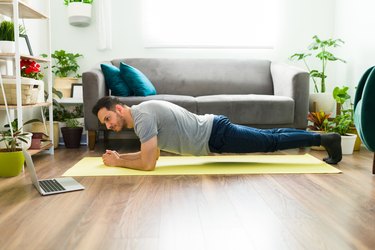
Most of us don't have hours to spend at the gym working on our abs every day, but we still want a strong core. Luckily, you don't need endless time to build a mighty midsection, just a smart strategy: training efficiently with the most effective exercises. Enter the plank tuck.
The plank tuck is one of those unique bang-for-your-buck core movements that truly tones you from head to toe.
Video of the Day
This moving plank variation, which starts in a high plank and requires you to hop your feet toward your hips, not only strengthens multiple core muscles, but the jumping aspect also gets your heart pumping to promote your cardiovascular health, says Winnie Yu, PT, DPT, CPT, a physical therapist at Bespoke Treatments.
But that's not all the benefits of plank tucks — they sculpt your upper and lower body too.
In other words, they can level up your fitness no matter your goals. Aiming to build muscular strength? Yu recommends tagging plank tucks onto the end of your strength training routine to serve as a sweaty core finisher. (This order — lift first, plank tucks last — will also keep your muscles from becoming too fatigued.)
If your goal is to enhance your endurance, start with plank tucks at the top of your sweat session, Yu says.
No matter your objective, 3 rounds of 30 seconds (or 3 sets of 10 to 12 repetitions) should be sufficient to reap all the benefits. Just make sure to rest for 30 seconds (or more) between sets: Plank tucks can tucker you out, especially when you're still getting the hang of them.
How to Do the Plank Tuck
- Start in a high plank position with your wrists, elbows and shoulders stacked. Your shoulders, hips and ankles should be in a straight line.
- Be mindful to keep your hips level in this plank position. Sagging hips can place excessive pressure onto your lower back.
- Push away from the ground to activate the muscles that support your shoulders and keep your gaze down (about 3 to 4 inches in front of your hands) to protect your neck.
- While engaging through your core and glutes, hop the feet forward to bring your knees toward your chest. Jump your feet back to return to the high plank position.
- Repeat for 20 to 30 seconds or 10 to 12 repetitions.
Tip
If the plank tuck is too strenuous, you can progress the movement slowly, Yu says. First, work on holding a high plank with perfect form. Once you’ve mastered this stationary exercise, try adding in some movement. Yu recommends starting with bear plank to high plank, a low-impact variation which utilizes the same movement pattern as the plank tuck minus the jumping.
- Start on all fours with your wrists, elbows and shoulders stacked and knees under the hips.
- Push away from the ground to activate the muscles that support the shoulders.
- Engage your core and lift your knees off the ground to find the bear plank position.
- Step each foot back to a high plank position.
- Walk each foot back to the bear plank position. Repeat 10 times.
4 Plank Tuck Benefits
Here are the top reasons to add the plank tuck to your weekly exercise rotation.
1. It Targets Multiple Core Muscles
Many core exercises only rev up your rectus abdominis (aka your six pack), but plank tucks activate various ab muscles in addition to these, including your obliques and transverse abdominis (i.e., deeper core muscles).
This multitargeted effect has to do with the exercise's compound movement. When you start "in the plank position, your core is activated to help maintain a stable pelvis and hip position," Yu says.
Then, "as you jump forward into the tuck position, you have to use your core muscles to stabilize the pelvis and back throughout the motion," she adds.
In other words, this dynamic movement pattern requires the coordination of many core muscles.
2. It Ramps Up Your Heart Rate
Tired of the treadmill? Plank tucks are a terrific way to fit a little cardio into your workout.
"As this exercise works the whole body, it requires a greater demand of energy to perform," Yu says. "This leads to a faster increase in heart rate and is a great option for cardiovascular training."
To really challenge your cardiovascular system, only rest for 15 to 30 seconds between each set of plank tucks, Yu recommends.
3. It Sculpts Your Shoulders
If you're searching for new ways to build arm and shoulder strength, look no further than plank tucks.
"This plank exercise helps to strengthen your shoulder girdle musculature, i.e., the muscles that support the shoulders, arms and upper back," Yu says.
And "with the additional tuck portion of the exercise, you further challenge your shoulder stability because you have to lift your legs off the ground," she adds.
Put simply, plank tucks totally tone your shoulders.
4. It Strengthens Your Hip Flexors
Not only do plank tucks promote a powerful upper body, but they also boast benefits for your hips as well. Here's why: When you perform the tuck part of the movement, your hip flexors must activate to bring your legs closer to your arms, Yu says.
And building strength and mobility in your hip flexors is fundamental. That's because inflexible or feeble hip flexors can produce other pesky problems such as back pain.
Unfortunately, many of us suffer with tight, weak hips thanks to habits like sitting too much. Which is why doing exercises like plank tucks, which help keep your hips loose, limber and strong, is so important.


